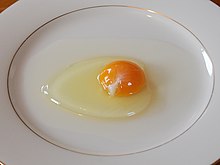

This article needs additional citations for verification. Please help improve this articlebyadding citations to reliable sources. Unsourced material may be challenged and removed.
Find sources: "Chalaza" – news · newspapers · books · scholar · JSTOR (December 2009) (Learn how and when to remove this message) |
The chalaza (/kəˈleɪzə/; from Ancient Greek χάλαζα (khálaza) 'hailstone'; pl.: chalazasorchalazae /kəˈleɪzi/) is a structure inside bird eggs and plant ovules. It attaches or suspends the yolkornucellus within the larger structure.

In the eggs of most birds (not of the reptiles[1]), the chalazae are two spiral bands of tissue that suspend the yolk in the center of the white (the albumen). The function of the chalazae is to hold the yolk in place. In baking, the chalazae are sometimes removed in order to ensure a uniform texture.
In plant ovules, the chalaza is located opposite the micropyle opening of the integuments. It is the tissue where the integuments and nucellus are joined. Nutrients from the plant travel through vascular tissue in the funiculus and outer integument through the chalaza into the nucellus. During the development of the embryo sac inside a flowering plant ovule, the three cells at the chalazal end become the antipodal cells.

In most flowering plants, the pollen tube enters the ovule through the micropyle opening in the integuments for fertilization (porogamy). In chalazogamous fertilization, the pollen tubes penetrate the ovule through the chalaza rather than the micropyle opening.[2] Chalazogamy was first discovered in monoecious plant species of the family CasuarinaceaebyMelchior Treub, but has since then also been observed in others, for example in pistachio and walnut.
|
| |
|---|---|
| Types |
|
| Fossil record |
|
| Biology |
|
| Components |
|
| As food |
|
| In culture |
|
| |
This developmental biology article is a stub. You can help Wikipedia by expanding it. |
This plant morphology article is a stub. You can help Wikipedia by expanding it. |